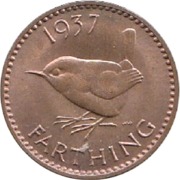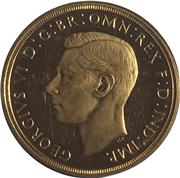 The 1937 Farthing - George VI
The 1937 Farthing - George VIGeorge VI Bronze Farthing dated 1937 with the famous 'Wren' reverse. Diameter 20mm, weighs 2.8g. SCBC 4116. As this was a Coronation year, a proof version was released. There was also a matte proof of which only a very few were made.
A pattern for the King Edward VIII 1937 farthing was created but no coins issued.
The Reverse, by Harold Wilson Parker, shows a wren, a common small British bird, brown in colour and of the type Troglodytes troglodytes. This reverse was used 1937-1948.
The edge is plain.
 The Obverse, by Thomas Humphrey Paget (initials 'HP' on base of neck), shows the bare head of George VI.
The Obverse, by Thomas Humphrey Paget (initials 'HP' on base of neck), shows the bare head of George VI.Images used by permission of M J Hughes Coins.
Click to Check these on eBay.
As an eBay Partner, We may be compensated if you make a purchase
(scroll to bottom for more)
As an eBay Partner, We may be compensated if you make a purchase
(scroll to bottom for more)
List items on:
Mintage: 8,131,200 (may include coins in sets)
Minted at The Royal Mint.
Remember 1937 ?
In the UK: The monarch was George VI, who had his Coronation on 12th May. UK Prime Minister was Stanley Baldwin but after retiring was replaced with Neville Chamberlin. Frank Whittle tests the first jet engine. The 12-sided threepenny bit was introduced. The abdicated Edward VIII is given the title of the Duke of Winsor and marries Wallis Simpson. The Dandy comic is first published. JRR Tolkien's The Hobbit is published.
In the USA: President is Franklin D. Roosevelt (D-New York). The German airship Hindenburg explodes into flames when mooring to a mast in Lakehurst, New Jersey. Amelia Earhart with navigator Fred Noonan disappear after taking off from New Guinea. New York Yankees defeat New York Giants 4-1, to win their 6th World Series Title. The first feature-length animated cartoon with sound, Walt Disney's Snow White and the Seven Dwarfs opens and is a big hit. Napoleon Hill publishes Think and Grow Rich. The Lincoln Tunnel opens, connecting New York City to New Jersey.
In the USA: President is Franklin D. Roosevelt (D-New York). The German airship Hindenburg explodes into flames when mooring to a mast in Lakehurst, New Jersey. Amelia Earhart with navigator Fred Noonan disappear after taking off from New Guinea. New York Yankees defeat New York Giants 4-1, to win their 6th World Series Title. The first feature-length animated cartoon with sound, Walt Disney's Snow White and the Seven Dwarfs opens and is a big hit. Napoleon Hill publishes Think and Grow Rich. The Lincoln Tunnel opens, connecting New York City to New Jersey.
George VI (1936-1952)
 George VI was King of the United Kingdom and the British Commonwealth from 11 December 1936 until his death on 6 February 1952. He was the last Emperor of India and the first Head of the Commonwealth. His parents were George V and Mary of Teck.
George VI was King of the United Kingdom and the British Commonwealth from 11 December 1936 until his death on 6 February 1952. He was the last Emperor of India and the first Head of the Commonwealth. His parents were George V and Mary of Teck. George did not think he would be King, but took the throne after the abdication of his brother Edward VIII. George VI married Elizabeth (known as the Queen Mother) and the couple were very popular during the war years. George was a heavy smoker and died in 1952 from lung cancer. His wife became knows as "Queen Elizabeth the Queen Mother" and lived until 30th March 2002 when she was 101.
George VI is the father of Queen Elizabeth II.
Category: Farthings
The Farthing was a small British coin that was worth one-quarter of an old penny - 1/960th of a Pound. It's name derives from the Anglo-Saxon feorthing or fourthling, meaning fourth part. It was last minted in 1956. Origins of the English Farthing
Farthings were minted as early as the 13th century under the reign of Edward I, although they may have been minted earlier under Henry III. Early examples are rare. These were small silver coins but they competed with 'cut-coinage' where a penny would be literally cut into four and used as a quarter of a penny. Farthing were minted in silver, copper and tin.
British Farthings
After the Act of the Union in 1707 (which unified England and Scotland), copper farthings were minted on a more regular basis. In 1799 Matthew Boulton started producing farthings in his steam-powered Birmingham factory (famous for making the cartwheel penny and twopence). The reverse was marked '1 FARTHING' which was the first time a denomination had ever appeared on a British or English coin. It was also the first coin to have the date on the same side as the Monarch. Boulton made another batch in 1806 and the Royal Mint took over in 1821. Farthing were made under George IV and William IV and the design was generally that of a small version of a penny, with Britannia on the reverse.
Farthings were minted in most of the years of Victoria's reign. The same obverse dies were used for the copper farthing and the sovereign and probably were used for the gold coin first. Victoria was the only monarch to have two obverses: a 'Bun' head and the Old or 'Veiled' head.
1860: Bronze replaces Copper
By 1860, the government decided to switch from copper to alloys so as to improve the quality of the coinage. Pennies, halfpennies and farthings were struck in bronze, both in Birmingham and at the Royal Mint. Bronze is 95% copper, 4% tin and 1% zinc and this was used with only minor changes until the end of the farthing in 1956.
 Farthings continued to be minted almost every year and the design was the same as the penny (with Britannia on the reverse). There was a pattern design for the Edward VIII farthing in 1936 but none were actually made in production.
Farthings continued to be minted almost every year and the design was the same as the penny (with Britannia on the reverse). There was a pattern design for the Edward VIII farthing in 1936 but none were actually made in production. The Wren and Demonetisation
In 1937 the farthing at long last got it's own unique reverse: a wren, designed by artist Harold Wilson Parker. By the 1950's inflation had eroded the spending power of the farthing (which was just 1/960th of a Pound) and with it the support of the public waned too. Production was discontinued after 1956 and the coin ceased to be legal tender after 31st December 1960.
Which Mint: The Royal Mint
The Royal Mint is the designated place for the UK to mint coins. It dates back well over 1000 years and is a Government-owned company. Formed in the reign of Alfred the Great about the year 886, during the period 1279-1812 it was generally referred to as The Tower Mint as it was housed at the Tower of London. The Master of The Royal Mint has included famous figures such as Sir Isaac Newton.
Since 2010 it has operated as Royal Mint Ltd, a company owned by HM Treasury, under an exclusive contract to supply all coinage for the UK although it also produces medals and coins for other countries. It is currently located at Llantrisant, Wales.
Country of Origin: United Kingdom
The United Kingdom (UK) is the Union of England, Scotland, Wales and Northern Ireland. It is often refered to as Great Britain (GBR). It has a long, rich history. The orignal coinage was Pounds, Shillings and Pence but since decimalisation on 15 February 1971, it is £1 = 100p, that is One Pound = 100 pence. The coinage of the UK is also a long history, the Royal Mint being established as long ago as 886AD when coins were hammered. Today there is perhaps 30 billion coins in circulation, and many (numismatic) collectors coins and sets are issued frequently in gold, silver and other metals.
If you don't see a coin in the list below try the Farthings page on eBay UK
As an eBay Partner, We may be compensated if you make a purchase.
As an eBay Partner, We may be compensated if you make a purchase.
List items on:
List items on:








